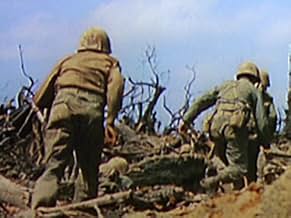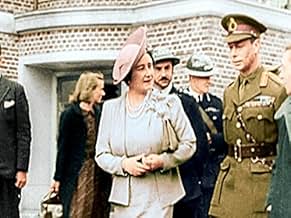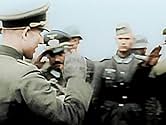IMDb RATING
8.7/10
7.8K
YOUR RATING
Recounts the events of world War II in color.Recounts the events of world War II in color.Recounts the events of world War II in color.
Browse episodes
Featured reviews
This show demonstrate how unreliable human being are and how far they go due to their incomplete and sometimes wrong believes.
Going through the events occurred during WW II over and over again coming to conclusion that human will eventually destroy itself is inevitable.
The irony is human being having concerns regarding artificial intelligence and machine controlling human life. Yet that could be the only solution to not let human being destroy itself.
All these events happen about a century ago and still we see several evidences, that even up to presidential level of super power countries acting the same if not worse and supported by millions of people.
Seriously, we should not only let but beg machines to save us from ourselves before it is too late.
Going through the events occurred during WW II over and over again coming to conclusion that human will eventually destroy itself is inevitable.
The irony is human being having concerns regarding artificial intelligence and machine controlling human life. Yet that could be the only solution to not let human being destroy itself.
All these events happen about a century ago and still we see several evidences, that even up to presidential level of super power countries acting the same if not worse and supported by millions of people.
Seriously, we should not only let but beg machines to save us from ourselves before it is too late.
The color process is both fantastic and jarring in bringing the our eyes old events that come back to life in a way that is emotional and very real. The old black and white films were like watching old history about a far past, but the color of the war film changes to feeling from memory to seeing moments in a new mind frame about that mentally sees the conflict in modern terms to appreciate and emotionally see and feel the events.
Short and not overwhelming. Great for anyone that's interested in the second World War.
For the first time you can actually view footage from the war in color
Spectacular for anyone ages 13-100
some violent footage is in it so if you're sensitive you might have to reconsider.
Maps are really fascinating and well done.
Robert Powell also does a fantastic job. His accent makes everything simple to understand.
IS IT GOOD FOR EDUCATION?
Yes. It's amazing for education since the episodes cover everything from A-Z.
My favorite segment is the "battle of the islands" where they talk about America vs Japan. Probably my favorite segment because it has tons of footage in it.
For the first time you can actually view footage from the war in color
Spectacular for anyone ages 13-100
some violent footage is in it so if you're sensitive you might have to reconsider.
Maps are really fascinating and well done.
Robert Powell also does a fantastic job. His accent makes everything simple to understand.
IS IT GOOD FOR EDUCATION?
Yes. It's amazing for education since the episodes cover everything from A-Z.
My favorite segment is the "battle of the islands" where they talk about America vs Japan. Probably my favorite segment because it has tons of footage in it.
The segment "The Island War" treats the liberation of the Phillipines as an unnecessary and overly costly (and therefore ill-advised) operation. However, that totally fails to recognize that in war, there are both military and political concerns and that grand strategy requires the consideration of both. War is, quite simply, foreign policy pursued by other means. Therefore, foreign policy has to be considered in the strategy of the war.
Because the USA had a commitment to the Phillipine people as a protectorate, it was politically necessary to return as soon as was humanly possible. MacArthur may have left, but Phillipine guerrillas had been fighting and dying against the Japanese with US supplies and coordination from the very beginning. To ignore a chance to liberate the Phillipines would have been no different than leaving Paris in German hands while liberating Holland and Belgium. It was politically imperative! Likewise, the episode maintained that the "Northern arm" of the Japanese pincer had "only pretended to retreat and under cover of darkness had reversed course..." both Japanese and American accounts, much closer to the event when interviews with actual participants were available, indicated that the Northern force actually intended to retreat and only reversed course following critical comments from the high command.
Halsey had every reason to have believed that the Northern force was less a threat than Ozawa's aircraft carrier force which had just been spotted. Every previous naval victory in WWII had come at the hands of the aircraft carriers, NOT the battleships. When confronted by two enemies... one with a knife and the other with a machine gun, only the fool deals with the knife first! There were American POWs held in the Phillipines. Many were saved during this operation. The civilian casualties were indeed great, but that was the choice of the Japanese occupiers and how many would've died, either of brutality or starvation had the islands been bypassed? The further we get from WWII, the less accurate do the "documentaries" become. You can tell a good story with the films, but unless you have spent years studying the contemporary histories, from both sides... false conclusions will run rampant. As the last of the participants pass from this life, there can be no more "factual" accounts. The eyewitnesses are silent now. Don't just watch, READ, READ, READ the books that were published before 1960.
Because the USA had a commitment to the Phillipine people as a protectorate, it was politically necessary to return as soon as was humanly possible. MacArthur may have left, but Phillipine guerrillas had been fighting and dying against the Japanese with US supplies and coordination from the very beginning. To ignore a chance to liberate the Phillipines would have been no different than leaving Paris in German hands while liberating Holland and Belgium. It was politically imperative! Likewise, the episode maintained that the "Northern arm" of the Japanese pincer had "only pretended to retreat and under cover of darkness had reversed course..." both Japanese and American accounts, much closer to the event when interviews with actual participants were available, indicated that the Northern force actually intended to retreat and only reversed course following critical comments from the high command.
Halsey had every reason to have believed that the Northern force was less a threat than Ozawa's aircraft carrier force which had just been spotted. Every previous naval victory in WWII had come at the hands of the aircraft carriers, NOT the battleships. When confronted by two enemies... one with a knife and the other with a machine gun, only the fool deals with the knife first! There were American POWs held in the Phillipines. Many were saved during this operation. The civilian casualties were indeed great, but that was the choice of the Japanese occupiers and how many would've died, either of brutality or starvation had the islands been bypassed? The further we get from WWII, the less accurate do the "documentaries" become. You can tell a good story with the films, but unless you have spent years studying the contemporary histories, from both sides... false conclusions will run rampant. As the last of the participants pass from this life, there can be no more "factual" accounts. The eyewitnesses are silent now. Don't just watch, READ, READ, READ the books that were published before 1960.
Recently I watched this documentary series about World War II in (HD) color on Netflix and really liked it. In 14 episodes you get to see a well documented overview of WW2, starting with the events leading up to WW2 in both Europe and Sout-East Asia, the beginning stages with the fast advances both Germany and Italy made in Europe, and Japan in Asia, the mistakes made by the aggressors, the fighting back by the allied forces on different theatres, and ultimately the victories over Germany , Italy and Japan.
The interesting part about this series is that the original black & white footage has been coloured by advanced colouring techniques. While you can occasionally spot the clearly artificial colouring, most of the times it is unobtrusive and hardly noticeable. Watching these scenes in colour definitely add an aspect of realism to them, compared to the same scenes in black & white.
There are many documentaries about World War II, and this documentary deserves a good place between them.
The interesting part about this series is that the original black & white footage has been coloured by advanced colouring techniques. While you can occasionally spot the clearly artificial colouring, most of the times it is unobtrusive and hardly noticeable. Watching these scenes in colour definitely add an aspect of realism to them, compared to the same scenes in black & white.
There are many documentaries about World War II, and this documentary deserves a good place between them.
Did you know
- TriviaThough not listed among crew, the show credits Blair Wallace as colourist for the series.
- ConnectionsFeatured in History Buffs: Saving Private Ryan (2016)
- How many seasons does World War II in Colour have?Powered by Alexa
Details
- Release date
- Country of origin
- Language
- Also known as
- World War 2 in HD Colour
- Production companies
- See more company credits at IMDbPro
- Runtime51 minutes
- Color
- Aspect ratio
- 16 : 9
Contribute to this page
Suggest an edit or add missing content





















